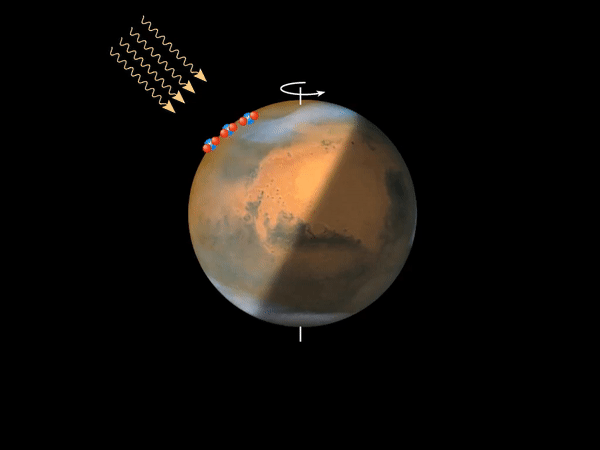The Trace Gas Orbiter mission, a European Space Agency craft, has reported the first detection of visible light of nightglow on Mars. This effect, well known on Earth and photographed by many astronauts, was expected to also happen on Mars. But it had never been seen before in visible light.
The nightglow looks similar but it is unrelated to aurorae – which on Mars actually shine in ultraviolet light. Sunlight splits carbon dioxide molecules by giving them energy. Some of the single oxygen atoms migrate from the daylight side to the night side of Mars and towards the polar region currently in winter. Once sunlight is no longer exciting the atoms, a pair of them form an oxygen molecule, producing a green glow around 50 kilometers (31 miles) above the planet’s surface.
“This emission is due to the recombination of oxygen atoms created in the summer atmosphere and transported by winds to high winter latitudes, at altitudes of 40 to 60 km [25 to 37 miles] in the Martian atmosphere,” co-author Lauriane Soret, from the University of Liège, said in a statement.

Some of the oxygen freed from the carbon flies to the polar region and, in the night, recombines, emitting a glow.
Image Credit: ESA
Based on the estimation from Trace Gas Orbiter, the glow should be bright enough to be seen from the ground in the polar winter nights – maybe by future astronauts or a robotic explorer. The glow of oxygen atoms on the dayside of Mars was detected by the spacecraft back in 2020, the first time it was detected on a planet other than Earth. This suggested that a nightglow should also be detected, but it did not prepare the scientists for the brightness.
“These observations are unexpected and interesting for future trips to the Red Planet,” added Jean-Claude Gérard, lead author of the new study and planetary scientist at the University of Liège.
Beyond illuminating the path to the base for a future Martian astronaut, there are intriguing scientific reasons for being excited about the nightglow. Mars’s tenuous atmosphere (just 1 percent of Earth’s own) is not the easiest to study and many processes happening at high altitudes are even less so.
The nightglow provides novel insights in those regions as well giving a better estimate of just how much oxygen is present in the atmosphere (it is very little). And it can provide new information on how sunlight and the solar wind interact with the atmosphere of the Red Planet. Mars likely used to have a denser atmosphere which has been eroded away by the solar wind.
Studies of the atmosphere and its density inform potential drag on the orbiters and how and when to deploy parachutes for the probes that land on Mars.
The study is published in Nature Astronomy.
Source Link: Martian Polar Nights Will Glow Green For Future Astronauts